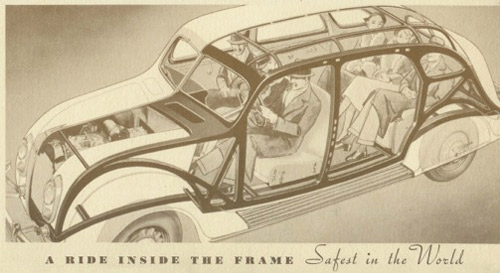The Chrysler Airflow

The Airflow was a major risk for Chrysler, but their people believed the public was ready for something fresh and streamlined. The catalyst was really Carl Breer (chief engineer) and his curiosity for shapes and movement. Rumor has it Carl would sit at the Detroit airport and watch planes practice maneuvers for hours. After months of study, he was convinced there was a ton to be learned from the aerodynamics of airplanes and contacted Orville Wright as a consultant.
By April of 1930, Carl, Orville, and two other Chrysler Engineers (Fred Zeder and Owen Skelton) had put the final touches on their wind tunnel and had begun testing basic shapes. It was quickly realized that the then popular “two-box” automotive design was incredibly inefficient and was, in fact, much more aerodynamic when turned around backwards. Using the ass-end of a late 30’s prototype Chrysler as a baseline, the team began designing the Airflow.

Not satisfied by simply copying the aerodynamic characteristics of an aircraft, the team also liberated aircraft construction techniques from the field. It was decided that unibody construction would be perfect to keep their body low and light and the loaded weight distribution neutral. Once it was all penciled in, the engine was moved forward over the front axle and the passengers placed within the wheel base. This resulted in a very soft ride for the day and pretty damn good handling characteristics to boot…
In 1933, Chrysler was ready to debut their new car. As a marketing stunt, an Airflow was built with reversed axles and steering gear allowing the car to be driven backwards throughout Detroit. People freaked out and word began to flow about Chrysler’s new thinking. However, the car was introduced months before it was put into production and it was well into 1934 before the public could actually get up close to the new car.
The rushed production schedule lead to a number of manufacturing flaws. As motor mounts broke and engines literally leapt from cars, the Airflow started to earn a reputation as a lemon… And the look? People just weren’t ready for the air streamed body and the low slung chassis. The verdict was out and there was no saving Chrysler. Brilliant minds had conceived of an amazing car, but manufacturing and a close-minded public had let them down. In the end, only around 28,000 Airflows left dealer lots and the project was canceled in 1937.
As often is the case, this Detroit failure makes a really non-traditional but very cool basis for a custom car. In fact, this little article was actually spawned from a recent post on the H.A.M.B. that features some really nice ideas. Think a little bit…


